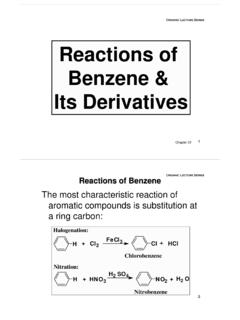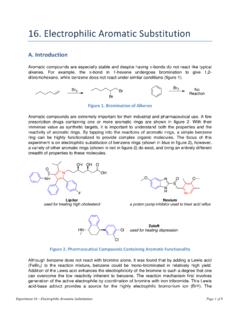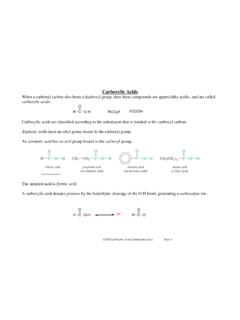Transcription of Benzene and Its Derivatives
1 282 Peppers of the capsicum family. Hot peppers contain significant amounts of the chemical capsaicin, which is used for medicinal purposes as well as for tantalizing taste buds (see Chemical Connections, Capsaicin, for Those Who Like It Hot ). Inset: A model of capsaicin. (Courtesy Douglas Brown)09 Benzene and Its Derivatives What Is the Structure of Benzene ? What Is Aromaticity? How Are Benzene Compounds Named, and What Are Their Physical Properties? What Is the Benzylic Position, and How Does It Contribute to Benzene Reactivity? What Is electrophilic aromatic substitution ? What Is the Mechanism of electrophilic aromatic substitution ? How Do Existing Substituents on Benzene Affect electrophilic aromatic substitution ? What Are Phenols?HOW How to Determine Whether a Lone Pair of Electrons Is or Is Not Part of an aromatic Pi How to Determine Whether a Substituent on Benzene Is Electron WithdrawingCHEMICAL CONNECTIONS9A Carcinogenic Polynuclear Aromatics and Cancer9B Capsaicin, for Those Who Like It HotKEY QUESTIONSBENZENE, A COLORLESS LIQUID, was first isolated by Michael Faraday in 1825 from the oily residue that collected in the illuminating gas lines of London.
2 Benzene s molecular formula, C6H6, suggests a high degree of unsaturation. For comparison, an alkane with six carbons has a molecular formula of C6 H14, and a cycloalkane with six carbons has a molecular formula of C6H12. Considering Benzene s high degree of unsaturation, it might be expected to What Is the Structure of Benzene ?show many of the reactions characteristic of alkenes. Yet, Benzene is remarkably unreactive! It does not undergo the addition, oxidation, and reduction reactions characteristic of alkenes. For example, Benzene does not react with bromine, hydrogen chloride, or other reagents that usually add to carbon carbon double bonds. Nor is Benzene oxidized by peracids under con-ditions that readily oxidize alkenes. When Benzene reacts, it does so by substitution in which a hydrogen atom is replaced by another atom or a group of term aromatic was originally used to classify Benzene and its Derivatives because many of them have distinctive odors.
3 It became clear, however, that a sounder classification for these compounds would be one based on structure and chemical reactivity, not aroma. As it is now used, the term aromatic refers instead to the fact that Benzene and its Derivatives are highly unsaturated compounds that are unexpectedly stable toward reagents that react with use the term arene to describe aromatic hydrocarbons, by analogy with alkane and alkene. Benzene is the parent arene. Just as we call a group derived by the removal of an H from an alkane an alkyl group and give it the symbol RJ, we call a group derived by the removal of an H from an arene an aryl group and give it the symbol What Is the Structure of Benzene ?Let us imagine ourselves in the mid-nineteenth century and examine the evidence on which chemists attempted to build a model for the structure of Benzene .
4 First, because the molecular formula of Benzene is C6 H6, it seemed clear that the molecule must be highly unsaturated. Yet Benzene does not show the chemical properties of alkenes, the only un-saturated hydrocarbons known at that time. Benzene does undergo chemical reactions, but its characteristic reaction is substitution rather than addition. When Benzene is treated with bromine in the presence of ferric chloride as a catalyst, for example, only one compound with the molecular formula C6 H5 Br forms:C6H6 Br2 FeCl3 C6H5Br HBr Benzene BromobenzeneChemists concluded, therefore, that all six carbons and all six hydrogens of Benzene must be equivalent. When bromobenzene is treated with bromine in the presence of ferric chlo-ride, three isomeric dibromobenzenes are formed:C6H5Br Br2 FeCl3 C6H4Br2 HBr Bromobenzene Dibromobenzene (formed as a mixture of three constitutional isomers)For chemists in the mid-nineteenth century, the problem was to incorporate these observations, along with the accepted tetravalence of carbon, into a structural formula for Benzene .
5 Before we examine their proposals, we should note that the problem of the struc-ture of Benzene and other aromatic hydrocarbons has occupied the efforts of chemists for over a century. It was not until the 1930s that chemists developed a general understanding of the unique structure and chemical properties of Benzene and its Kekul s Model of BenzeneThe first structure for Benzene , proposed by August Kekul in 1872, consisted of a six-membered ring with alternating single and double bonds and with one hydrogen bonded to each carbon. Kekul further proposed that the ring contains three double bonds that shift back and forth so rapidly that the two forms cannot be separated. Each structure has become known as a Kekul compound A term used to classify Benzene and its An aromatic group A group derived from an aromatic compound (an arene) by the removal of an H; given the symbol The symbol used for an aryl group, by analogy with RJ for an alkyl 9 Benzene and Its Derivatives284 Kekul incorrectly believed that the doublebonds of Benzene rapidly shift back and forthKekul structuresas line-angle formulasA Kekul structure,showing all atomsCCCCCCHHHHHH Because all of the carbons and hydrogens of Kekul s structure are equivalent, sub-stituting bromine for any one of the hydrogens gives the same compound.
6 Thus, Kekul s proposed structure was consistent with the fact that treating Benzene with bromine in the presence of ferric chloride gives only one compound with the molecular formula C6 H5 proposal also accounted for the fact that the bromination of bromobenzene gives three (and only three) isomeric dibromobenzenes:The three isomeric dibromobenzenesBr+Br2 BrBrBrBrBrBr+++HBrFeCl3 Although Kekul s proposal was consistent with many experimental observations, it was contested for years. The major objection was that it did not account for the unusual chemical behavior of Benzene . If Benzene contains three double bonds, why, his critics asked, doesn t it show the reactions typical of alkenes? Why doesn t it add three moles of bromine to form 1,2,3,4,5,6-hexabromocyclohexane?
7 Why, instead, does Benzene react by substitution rather than addition?B. The Orbital Overlap Model of BenzeneThe concepts of the hybridization of atomic orbitals and the theory of resonance, devel-oped by Linus Pauling in the 1930s, provided the first adequate description of the structure of Benzene . The carbon skeleton of Benzene forms a regular hexagon with CJCJC and HJCJC bond angles of 120 . For this type of bonding, carbon uses sp2 hybrid orbitals (Section ). Each carbon forms sigma bonds to two adjacent carbons by the overlap of sp2 sp2 hybrid orbitals and one sigma bond to hydrogen by the overlap of sp2 1s orbitals. As determined experimentally, all carbon carbon bonds in Benzene are the same length, , a value almost midway between the length of a single bond between sp3 hybridized carbons ( ) and that of a double bond between sp2 hybridized carbons ( ):CCCCCCHHHHHH120 120 120 sp2-sp2sp2-1sEach carbon also has a single unhybridized 2p orbital that contains one electron.
8 These six 2p orbitals lie perpendicular to the plane of the ring and overlap to form a continuous pi cloud encompassing all six carbons. The electron density of the pi system of What Is the Structure of Benzene ?a Benzene ring lies in one torus (a doughnut-shaped region) above the plane of the ring and a second torus below the plane (Figure ).C. The Resonance Model of BenzeneOne of the postulates of resonance theory is that, if we can represent a mol-ecule or ion by two or more contributing structures, then that molecule cannot be adequately represented by any single contributing structure. We represent Benzene as a hybrid of two equivalent contributing structures, often referred to as Kekul structures: Benzene as a hybrid of two equivalentcontributing structures Each Kekul structure makes an equal contribution to the hybrid; thus, the CJC bonds are neither single nor double bonds, but something intermedi-ate.
9 We recognize that neither of these contributing structures exists (they are merely alternative ways to pair 2p orbitals with no reason to prefer one over the other) and that the actual structure is a superposition of both. Neverthe-less, chemists continue to use a single contributing structure to represent this molecule because it is as close as we can come to an accurate structure within the limitations of classical Lewis structures and the tetravalence of The Resonance Energy of BenzeneResonance energy is the difference in energy between a resonance hybrid and its most sta-ble hypothetical contributing structure. One way to estimate the resonance energy of ben-zene is to compare the heats of hydrogenation of cyclohexene and Benzene ( Benzene can be made to undergo hydrogenation under extreme conditions).
10 In the presence of a transition metal catalyst, hydrogen readily reduces cyclohexene to cyclohexane (Section ): H2Ni1 2 atm $H 0 120 kJ mol ( kcal mol)By contrast, Benzene is reduced only very slowly to cyclohexane under these conditions. It is reduced more rapidly when heated and under a pressure of several hundred atmo-spheres of hydrogen:+3 H2Ni200 300 atmbecause Benzene does not react readily with reagents that add to alkenes, hydrogenation of Benzene must be performed at extremely high pressures $H 0 209 kJ mol ( kcal mol)The catalytic reduction of an alkene is an exothermic reaction (Section ). The heat of hydrogenation per double bond varies somewhat with the degree of substitution of the double bond; for cyclohexene $H 0 120 kJ/mol ( kcal/mol).







